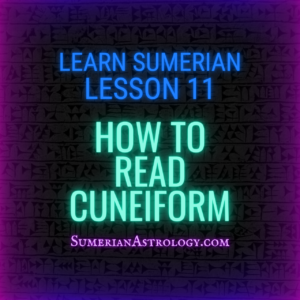Lesson 11
How to Read Cuneiform
In this lesson, you’ll learn how to read cuneiform word-signs. You’ll also learn about its development, which will help you make sense of the logographic script! And, you’ll learn about Sumerian determinitives!
Need a Refresher on Cuneiform?
Helpful Terms
- cuneiform: a wedge-shaped logo-syllabic script developed by the Sumerians and used by the Akkadians, Assyrians, and Babylonians, and currently recognized as the oldest known writing system.
- determinative (det.): an unpronounced word prefixed or suffixed to a noun to indicate classification.
Vocabulary to Memorize
I highly recommend memorizing these Sumerian words, as you’ll encounter them often in the upcoming lessons!
- eden 𒂔 n., desert, plain, steppe, open country.
- ga 𒂵 n., milk. v., to bring, carry. part., nominalizing suffix when preceded by /g/.
- ku6 𒄩 n., fish. det., indicates a type of fish or (semi)aquatic animal.
- kur 𒆳 n., mountain(s), highland; foreign land; underworld, netherworld. v., to reach, attain; rise; to kindle, ignite, burn.
- mul 𒀯 n., celestial body, star, planet, constellation, meteor; arrow. part., indicates a celestial body or constellation.
Vocabulary--Full List
I highly recommend reading through and familiarizing yourself with these Sumerian words, as: 1) you’ll be encountering many of these in the upcoming lessons, and 2) some of the words you’ve already learned may have been updated with additional meanings!
- àm 𒀀𒀭 cop., he/she/it is.
- an 𒀭 n., heaven; high. det., indicates the name of a deity.
- ba 𒁀 n., allotment, portion, wages. v., to give; pay; divide; distribute; allot.
- diĝir 𒀭 n., god, deity. det., indicates the name of a deity (abbr. d)
- dilmunki 𒉌𒌇𒆠 n., ancient city/territory near the Persian Gulf in modern-day Kuwait.
- eden 𒂔 n., desert, plain, steppe, open country.
- e-ne 𒂊𒉈 pron., he/she, him/her, that one (pers.); to whom (OB); to you (pl.) (OB).
- denki 𒀭𒂗𒆠 n., Sumerian god of fresh water, creation, wisdom, and crafts.
- ga 𒂵 n., milk. v., to bring, carry. part., nominalizing suffix when preceded by /g/.
- ĝiš 𒄑 n., tree, wood; tool; organ; plow. adj., wooden. det., indicates a type of tree, or wooden object.
- iri 𒌷 n., city, town, village, district. det., indicates the name of a city.
- ki 𒆠 n., earth, area. prep., where. det., indicates a geographic location.
- ku6 𒄩 n., fish. det., indicates a type of fish or (semi)aquatic animal.
- kug 𒆬 n., (precious) metal; silver; money. v., to be pure, holy, sacred; to purify, sanctify. adj., bright, white; pure, sacred, holy.
- kur 𒆳 n., mountain(s), highland; foreign land; underworld, netherworld. v., to reach, attain; rise; to kindle, ignite, burn.
- me-en-zé-en 𒈨𒂗𒍢𒂗 cop., you are (pl.).
- mul 𒀯 n., celestial body, star, planet, constellation, meteor; arrow. part., indicates a celestial body or constellation.
- mušen 𒄷 n., bird. part., indicates a type of bird, insect, or winged animal.
- dnin-ḫur-saĝ 𒀭𒎏𒄯𒊕 n., oldest Sumerian mother goddess, embodied in the mountains; synonymous with ki 𒆠, the mother earth.
- nisi(g) 𒊬 n., greens, vegetables. adj., blue; green; beautiful. det., indicates a type of vegetable.
- tum 𒌈 n., work, action; cross-beam; quiver (of arrows). part., Akkadian feminine suffix.
- dutu 𒀭𒌓 n., Sumerian god of the sun, protection, and guidance.

How to Read Cuneiform
The Evolution of Cuneiform
Pictograms (c. 3400 BCE)
Cuneiform began as simple pictographs drawn in clay using a pointed writing tool. These images represented simple objects or concepts.
For example, the cuneiform sign 𒀭 is a literal depiction of a star. It can can be read an or diĝir, and mean sky, heaven, high, or deity respectively.
Reed Stylus (c. 3000 BCE)
Around 3000 BCE, the Sumerians began writing about more abstract concepts, leading to a change in the pictographic signs. Additionally, the pointed carving tool was replaced by the wedge-shaped read stylus, which resulted in the pictographic signs becoming more stylized.
Phonetic Elements (c. 2600 BCE)
Over the next few centuries, Cuneiform came to represent phonetic elements and ideas in addition to basic words and abstract concepts. This made it much easier to write longer texts full of complex ideas.
Direction and Orientation (c. 2400 BCE)
Originally, Cuneiform was written vertically, from top to bottom, and right to left. However, around 2400 BCE, the direction was changed to horizontal and left to right. Additionally, most of the vertical signs were turned 90 degrees.
HELPFUL TIP: If you want a better idea of what the original pictogram looked like, try tilting your head to the left when you look at it. Can you make out the hips and buttocks in the cunefiform sign tum 𒌈? Perhaps not surprisingly, tum 𒌈 is the Akkadian feminine suffix.
Word Boundaries
Unlike English, Sumerian sentences don’t use punctuation. Fortunately, Sumerian scribes and their successors usually kept individual sentences, phrases, or ideas on a single line. Sometimes, they even put slashes between them.
Many cuneiform texts are full of long sentences. Without punctuation, it can be difficult to tell where one word or phrase ends and the next begins.
Consider the following cuneiform sentence, as well as its English transliteration and translation. Without punctuation, it’s pretty painful on the eyes, regardless of the language.
- 𒌷𒆠𒆬𒆬𒂵𒀀𒀭𒂊𒉈𒁀𒀀𒀭𒈨𒂗𒍢𒂗𒆳𒉌𒌇𒆠𒆬𒂵𒀀𒀭
- irikikugkuggaàmenebaàmmeenzéenkurdilmunkikuggaàm
- purearethecitiesyouaretheonestowhomtheyareallottedtheforeignlanddilmusispure
Despite the lack of spacing and punctuation, you probably had a much easier time reading the English translation. That’s because your brain is familiar with the individual words, and can recognize the word boundaries.
With practice, you’ll be able to do this with Sumerian too, and when you look at the above, you’ll see:
- 𒌷𒆠𒆬𒆬𒂵𒀀𒀭 | 𒂊𒉈𒁀𒀀𒀭𒈨𒂗𒍢𒂗 | 𒆳𒉌𒌇𒆠𒆬𒂵𒀀𒀭
- iriki kug-kug-ga-àm | e-ne ba-àm me-en-zé-en | kur dilmunki kug-ga-àm
- pure are the cities | you are the ones to whom they are allotted | the foreign land of Dilmun is pure
But before you can reach this stage, you’ll need to start familiarizing yourself with Sumerian words, which we’ll be doing in the upcoming lessons, so be sure to subscribe to my substack!
*NOTE: The long stretch of text above is the first line of the Sumerian story “Enki and Ninhursaĝ” (denki 𒀭𒂗𒆠 dnin-ḫur-saĝ 𒀭𒎏𒄯𒊕), which describes the virginal land of Dilmun (dilmunki 𒉌𒌇𒆠), which many scholars believe to be the location of the biblical garden of Eden. Incidentally, the Sumerian word eden 𒂔 means desert, plain, steppe, or open country.
DeterМinatives
In the above sentence, notice how 𒌷𒆠 is transliterated as iriki and not iri-ki. That’s because, in this context, the word ki 𒆠 is a determinative; that is, a word written before or after a noun indicating its classification.
Before the Noun
Some determinatives come before the noun. For example, the cuneiform sign diĝir 𒀭, which means deity, comes before the proper names of gods, and even some kings, as in diĝirutu 𒀭𒌓, which is the name of the Sumerian god of the sun, Utu.
Some other determinatives you’ll see before a noun include:
- ĝiš 𒄑—indicates a type of tree, or an object made from wood
- mul 𒀯—indicates a celestial object (star, planet, constellation, etc.)
- iri 𒌷—indicates the proper name of a city
After the Noun
Some determinatives come after the noun, as in dilmunki 𒉌𒌇𒆠, which let’s us know that the name ‘Dilmun’, is a geographic location.*
Some common determinatives which follow nouns are:
- ku6 𒄩—indicates a type of fish or (semi)aquatic animal
- mušen 𒄷—indicates a type of bird, insect, or winged animal
- nisi(g) 𒊬—indicates a type of vegetable
Determinative Abbreviations
While learning Sumerian, keep in mind that some determinatives are abbreviated in transliteration. For example, diĝirutu 𒀭𒌓 is usually transliterated as dutu 𒀭𒌓.
Your Sumerian Language Journey Continues!
In the next lesson, you’ll learn about Sumerian nouns, so be sure to subscribe to my substack to get all of my articles as soon as they post!

